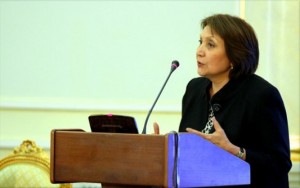
Professor Meruert Abusseitova spoke about Kazakh khanate’s diplomatic relations at the conference in Astana on 20 May 2015.
ASTANA – Issues of the formation and genesis of the Kazakh Khanate were reviewed May 22 during the international scientific-practical conference “From the Kazakh Khanate to independent Kazakhstan” hosted by the Nazarbayev Centre.
The symposium was attended by MPs, diplomatic corps, officials, analysts and scholars, including members of the Assembly of the People of Kazakhstan, in addition to representatives from Russia, Ukraine, Uzbekistan, Turkey and Italy. The event was organised by the Foundation of the First President of Kazakhstan and the Institute of History of the State, with additional support from the Nur Otan Party.
“Insight into the historical path of the nation from the Kazakh Khanate to independent Kazakhstan is not only of particular relevance in scientific terms, but also has great social significance today. The new reading of the history and evolution of the Kazakh Khanate will facilitate deeper understanding of the history by the younger generation and the formation of historical consciousness in modern society,” said conference moderator Professor Burkitbai Ayagan.
Majilis Deputy Kamal Burkhanov, a known historian himself, noted the Kazakh Khanate had many interesting aspects in its political, social and religious systems which could be relevant in modern society.
“The Sharia rules were not applied in the Kazakh Khanate. None of the Kazakh Bi [a leader of clan who also served as judge] used the stoning practice against his fellow countrymen and never cut off someone’s hands and feet. The Kazakh steppe lived under Genghis Khan’s code of laws, as well as those left by Kassym Khan, Yessim Khan and the Tauke Khan’s Zheti Zhargy (Seven Laws) code. In the Kazakh Khanate, religion did not interfere in politics. Khan did not hamper in the affairs of the mullahs, or the judge, the mullah did not interfere in the affairs of the Khan or Bi and everybody minded his own business. There was a delimitation of authority. It is important today, too,” he said.
Burkhanov added Kazakh women never wore the hijab.
“Islam came to us with a book, not with a sword, so the Kazakhs today ought to live by their own customs and traditions,” he concluded.
Professor of the Almaty-based Suleimenov Institute of Oriental Studies Meruert Abusseitova provided valuable copies of archival documents, unique historical finds which shed light on the development of the Kazakh Khanate. Copies of photographs and miniatures were found in foreign archives thanks to the “People in the stream of history” programme, which was initiated two years ago by President Nursultan Nazarbayev.
“The manuscripts and other documents we found illustrate that the Kazakh Khanate of the 15th-18th centuries was a state with a defined territory and established ethnic composition. The term ‘Kazakh’ had not only a political meaning but also an ethnic one. Along with the progress of political and trade relations, its diplomatic relations were evolving, too,” Abusseitova argued.
She showed a copy of a unique picture, the original of which is kept in a museum in France. It depicts the moment of diplomatic protocol: the ambassadors of the Kazakh Khanate brought a horse to the Chinese emperor, a most valuable gift for the nomads and rulers of different countries. The drawing was created by a Chinese court painter of Italian origin.
Correspondence between Abylai Khan, the prominent 18th century Kazakh ruler, and the Chinese emperor suggests that the Kazakh khans had a sophisticated chancellery of their own. The letters had the seal of Abylai Khan, indicating authenticity.
The conference also included a presentation of little-known papers of traveller Henri Moser, now stored in a Swiss museum in Bern, who visited the Kazakh steppes four times in the 1870s. He met with sultans Zhanturin, Seidallin and Baimukhamedov and as a sign of hospitality, they gave the traveller many decorative items from the yurt. A photo of those gifts is still kept in the Bern museum.
In the British library, Kazakh researchers found 16 thumbnails from the Kazakh Khanate era which were part of Tavarih-i Guzida-i Nusrat-namé, the prominent historical manuscript on Central Asian history from the 16th century.
The conference was accompanied by an exhibition of books dedicated to the Kazakh Khanate and artist Rakhimzhan Kassymzhan’s exhibition of black-and-white drawings entitled “Nomads of Eurasia.”
This article first appeared in the Liter newspaper and is translated and reprinted with permission.
